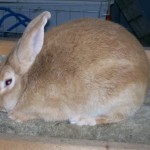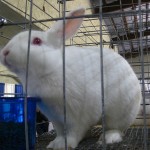It’s unsettling to me that people eat meat from stores, but fail to make the connection that meat comes from animals. I plan on raising rabbits for meat, as I’m not a huge meat eater. Here are my notes on breeding rabbits to eat and how it works together with aquaponics systems.
Let me start by saying these are my research notes for when I have rabbits for meat. I have not completed the hutch yet, but will as soon as I can make sure the rabbits won’t be overheated.
Rabbits produce 6 times as much meat for the same amount of food and water as a cow. Rabbits also take up a very small space comparatively to other types of livestock. For this reason, I plan on using rabbits for meat and as a method of self sustainability. I also want my children to know where meat comes from and to respect the cycle of life. I feel that as a society we are too distanced from the things that we depend on and as a result do not appreciate the very basic principles of life.
Rabbit Terms
Knowing the vocabulary will help as you learn more about rabbits. Here are some common rabbit terms that you will encounter:
- Kit
- A young rabbit
- Fryer
- 70-90 days of age, weight 3-5lb
- Roaster
- 90-180 days of age, weight 5-8lb
- Stewer
- 180+ days of age, weight over 8lb
- Buck
- A male rabbit
- Doe
- A female rabbit
- Coney
- An old rabbit
- Hutch
- A Rabbit cage
- Cull
- To “remove” the rabbit (eat, destroy, trade, etc).
- Fostering
- Putting rabbits from one litter into another doe’s litter if the litter is too large, or if the original mother rejected them.
- Cecotropes
- Poop that rabbits eat directly from their anus. It looks like mucus covered grapes.
- Weaned
- The age that a rabbit stops nursing, usually 6-8 weeks.
- Palomino
- Satin
- Chinchilla
- Rex
- Alfalfa (though be careful of alfalfa adding too much calcium to the diet)
- Coastal Hay
- Timothy Hay
- Vetch
- Cow Peas
- Dried bread and crust
- Vegetable parings and tops
- Any type of root vegetable
- Prepared rabbit pellet foods
- Whole grain
- Rabbits can stand cold, but not extreme heat
- Rabbits need clean water all day
- Cool, Leafy shade is great for rabbits
- Rabbits do not like to be soaked, it can kill them.
- You will need to clean the hutch once a week
- In cold weather, group 8 lbs of rabbits per cage and cover with a blanket
- Total Size
- A hutch for backyard production will take about 3′ by 10′
- Minimum Per Buck or Doe
- At a minimum you will want at least 3′ long, 2 1/2′ deep and 1 1/2′ high for each buck or doe.
- Hutch Frame
- Wood can be used as the outer frame, but it cannot be exposed to the rabbits as they will chew it. Wood might be harder to clean though too as it absorbs urine and will have a .
- Types of Hutch Wire
- Large chicken type wire can be used on the walls, but 1/2″ x 1″ or similar should be used for the cage bottoms to protect your rabbit’s feet.
- Door to Hutch
- You need an opening that allows you to easily reach everywhere in the hutch, and to add/remove a nesting box (14″ is suggested)
- Galvanized Wire
- 14guage 1/2″ by 1″ wire that is galvanized after weld is preferred.
- Keep rabbits in the shade
- Bury wire mesh into the ground several feet and use this as your rabbit hutch
- Mist (2 feet away, not directly on) your rabbits. If they stay wet for more than a few hours, flystrike could result.
- Swamp coolers
- Fans under the rabbit hutch, not through it
- Bottles of ice for the rabbits to lay on
- House them indoors
- snuffles
- weepy eye
- enteritis
- coccidiosis
- mastitis
- sore hocks
- wry neck
- malocclusion
- rabbit hemorrhagic disease
- 4 lb rabbit produces 2 lbs of eating meat
- Liver can be chopped into a sandwich spread
- Kidneys can be sliced and fried
- Innards or other portions can be fed to dogs and pigs
- Rabbit manure is high quality and can go directly into your vegetable garden – without burning plants
- Rabbit manure can drop into your worm bin directly from the hutch for great compost
- Rabbit fur can be used obviously
- Rabbit feet can be sold as good luck charms
- Cages clean?
- Other rabbits appear healthy?
- Sufficient food and water?
- Is there odor?
- Are flies under control?
- Are rabbits from same environment that you will place them?
- Is it old? Why is it being sold then? Cull?
- Are the insides of ears scabby (mites)?
- Are hocks and feet free of sores?
- Nose shouldn’t be wet, runny, or crusty
- droppings should be firm and round
- Does have 8 nipples
- Do the parents have meaty back legs?
Breeds of Meat Rabbits
The New Zealand White and Californian are the most popular meat breeds, but there are at least 40 other breeds too. The rabbit will produce slightly more than half of it’s body weight in meat when harvested. Here is a list of some of the most recommended breeds for the backyard rabbit keeper.
| Image | Breed Name | Weight |
|---|---|---|

|
New Zealand White | 10lbs |

|
Californian | 8.5lbs |
| charcoal ranges | Beveren | 9.5lbs |
 |
Palomino | 9.5lbs |

|
Florida White | 5lbs |
 |
Chinchilla | 3lbs |
Credit for images goes to wikipedia.org
Breeds of Fur Rabbits
I do not intend to raise rabbits for fur personally, however, I wanted list the breeds that are commonly used for fur:
Value of Rabbit Meat
I don’t plan to sell my rabbit meat, but I’ve read that if you are selling meat to a processor, they prefer white rabbits over colored ones, and most will not accept fryers older than 11 weeks.
What do Rabbits Taste Like
I’ve heard they taste like chicken but have more firm texture. The meat is considered all white meat. I’ll update this post once I taste my first harvest.
Is Rabbit Meat Healthy?
Look at this comparison chart for nutritional information about how rabbit meat compares to other types of meat. Measurements are on 1 pound of meat. Where possible, all data came from ground meat instead of select meat.
| Meat | Cholesterol | Calories | Fat | Protein |
|---|---|---|---|---|
| Rabbit | 742mg | 624 | 25g | 91g |
| Chicken | 996mg | 569 | 32g | 65g |
| Veal | ??mg | 653 | 31g | 88g |
| Lamb | 1132mg | 1279 | 106g | 75g |
| Turkey | ??mg | 559 | 31g | 65g |
| Lean Beef | 1041 | 947 | 62g | 90g |
| Pork | 1041 | 1193 | 96g | 76g |
What do Rabbits Eat?
Here is a list of the types of hay racks (cut into 4 inch lengths) that rabbits do well with:
Too much greens all at once might cause diarrhea if your rabbit is not accustomed to this. Hay helps rabbits to get rid of their hairballs.
A doe and litter will consume a clean gallon of water per day.
Adult rabbits require 12% protein in their diet. Nursing mothers and growing fryers need 20% protein.
Allow your fryers to eat as much as they can so they grow fast, but only feed adults about 3-6 ounces of pellets a day. A pregnant female needs 5-10 ounches a day. Nursing mothers may need as much as 20 ounces per day.
You can feed your rabbits scraps from root vegetables, but you will want their main source of food to be either a perfect balance of the proper hay, or store bought pellets. The pellets are going to be easier for the person just starting to raise rabbits for meat, and if your protein mixture isn’t just right, you will actually have a poor harvest on your rabbits.
How Often do Rabbits Reproduce
Two does and a buck will make 40-50 rabbits per year at 3lbs each. Any doe that does not produce 36 fryers per year (six litters of six fryers each), should likely be culled and replaced for maximum profit. After 5 to 6 years rabbits will stop producing as much and should be culled and replaced.
| Day | What happens |
|---|---|
| 1 | Put buck with doe until the doe is pregnant. |
| 27-29 | Provide a nest box for your doe |
| 2-33 | Gestation |
| 33 | Kindling – Litter of 6-9 is born |
| 34 | Check the nest box for any part of the litter that is dead, and remove it |
| 33-75 | Young Nurse and grow |
| 76 | Young are moved to separate hutch. Make sure the doe gets 2 weeks rest. |
| 77-117 | Eat/Process all young in this time period |
| 90 | Make sure young bucks are separate from does. Your breeders are ready again. |
You can eat the rabbits up to 8 months old, but if you wait this long the cost and food consumption of them is not profitable.
Older rabbits (3-4 years) make a good stew and their skins are worth more than fryers.
Rabbits can inbreed without issue most of the time. Take young does from the litter to the same buck without problems. It’s good to trade or buy a new buck about every 3 years.
Rabbit Hutches
Here are some key points to remember about rabbits:
How to Cool Rabbits
Rabbits can withstand up to -20F if there are no drafts, but above 85F-90F, most rabbits will die. Domesticated rabbits prefer 50-70F though, and if temperatures are too high, your bucks will not have a high sperm count. There are several methods of keeping your rabbits cool:
Rabbit Diseases
Tularemia (rabbit fever) is the only known disease that pass from rabbits to humans, but the feces can contain e. coli and salmonella. Tularemia symptoms in a rabbit would be shown as the rabbit acting “ill”, lethargic, swollen lymph nodes, and fever. Cooking the meat kills the bacteria that causes this.
Rabbits can get several diseases that cannot pass to humans, most of which is best to simply cull the sick animal to protect the rest of the herd. Disease can quickly spread and kill the rest of your herd. The common diseases to rabbits are:
What is Edible
I’m not sure without tasting each of the parts of rabbit, but here is a breakdown of edible meat and usuable parts from the rabbits:
Rabbit Manure Composition
This was found on http://www.ardengrabbit.com
| % | Chemical |
|---|---|
| 2.20% | Nitrogen |
| 0.87% | Phosphorus |
| 2.30% | Potassium |
| 0.36% | Sulfur |
| 1.26% | Calcium |
| 0.40% | Magnesium |
Dangers of Warm Blood Feces in Aquaponics
These are all excellent things to put into your aquaponics system; however, if you do have your rabbit cage on top of your aquaponics system, you will also need to be careful of bacteria like e. coli and salmonella. Worms love rabit manure, and a worm farm setup directly under your rabbits might be another alternative to cleaning up the massive amount of manure that rabbits will produce.
How to Buy Healthy Rabbits
You cannot truly tell if a rabbit is healthy before you buy it, but here are some things that might give you clues as you inspect the buyer’s rabbit production:
If your rabbits get sores on their feet, place a small 6″x10″ board where they can rest, away from their favorite pooping corners.
How to Pick Up a Rabbit
Don’t pick up a rabbit by it’s ears. Instead grab it gently but firmly by the scruff of the neck and scoop up under it’s bottom, supporting most of the weight on it’s feet in your hand. Be careful that it does not jump from your arms or scratch and claw if it’s not docile or used to being held.
Rabbit Resources
http://exclusivelyrabbits.blogspot.com
http://www.aarabbits.com/rabbit-breeders-directory.html
James,
Exellecent job by the way.
Things that I have found, been told, or learned:
-I was told alfalfa has alot of calcium. which in high amount and often adds calcium around the rabbits reproductive organs. a week and half ago i got rid of my alfalfa and feed them coastal hay. hay helps them break down their hairballs that they produce from cleaning themselves 5x day.
-wood hutches-they absorb the urine easily and increases the ammonia smells. too much of this with higher heat will kill the rabbits. especially the little ones.
-rabbit’s teeth grow 5 cm a year. wood is a good way for them to naturally keep their teeth down. i would put a piece of wood(also known as a toy to the rabbits) for this reason. then you have the controlled wood chewing.
-hutches-i cut a peice of plywood and put iton the floor of the hutch so the rabbit has a place to stand and rest without hurting his/her feet. they will poop on the board but it still saves their feet.
Again you did a great job.
Truman
Thanks Truman. Your hatchery inspired me to research more about rabbits and I’m glad I did. This article is mostly an overview of what to expect, and what to learn more about. Thank you for your feedback. I’ll add that to the article.
In the section titled How Often do Rabbits Reproduce, you note that a doe should have 6 litters per year but that you are only mating her every 90 days. There’s a mismatch there (I’m guessing the two sets of info came from different sources).
Commercial rabbitries (not that you want to emulate what they do!) often mate the doe the day after she kindles. I like to wait a couple of weeks after kindling (say, day 45-50 in your table) before mating her again. Mine also get about 3 months off across summer to rest – otherwise a really hot day can wipe out both the doe and the litter.
And don’t forget to use the rabbit bones for stock! It’s a lot like chicken stock. After jointing and filleting the meat off my rabbits, I often use 2-3 carcasses to make a pot of ragu. Just boil them up with celery, onions and carrots for an hour or two. Pick the meat off the bones and return it to the pot, add tomatoes and reduce to a thick sauce. It’s beautiful over pasta, especially with a gremolata garnish.